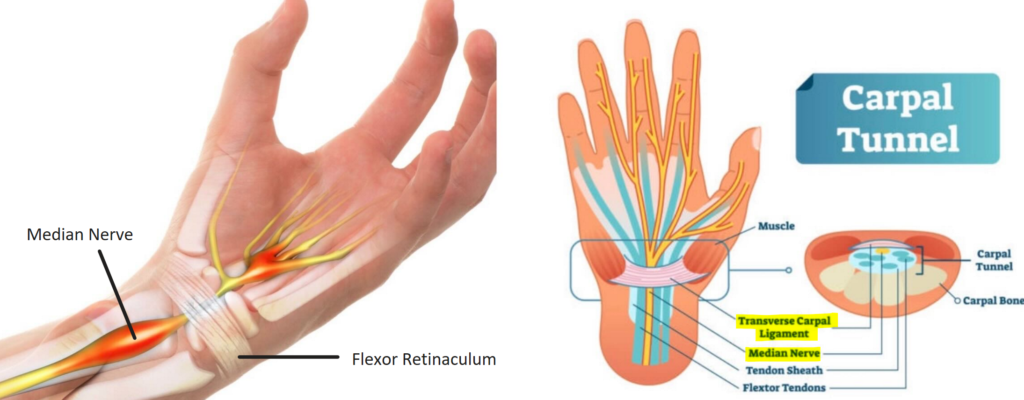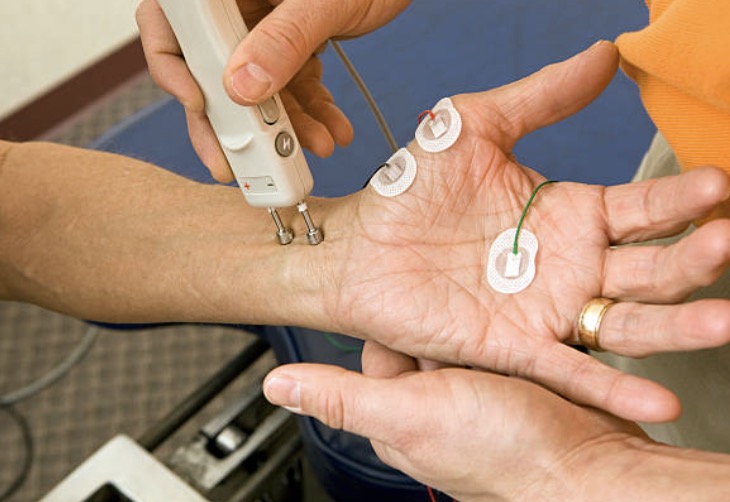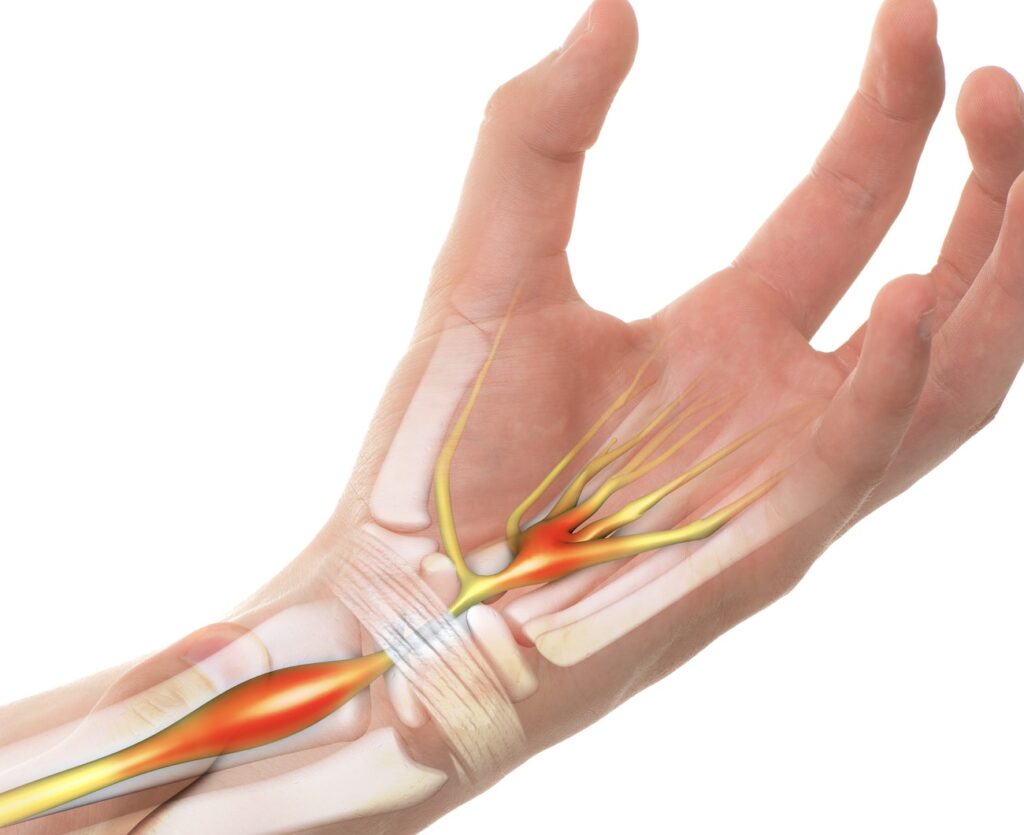What does it look like?
Wrist pain or numbness that shoots down the thumb, pointer and middle fingers, sometimes just the palm area. Worse at night, better when you shake it off. Maybe you’re starting to lose your grip, dropping stuff and finding it difficult to button up your shirt.
So what is it?
The culprit is something called carpal tunnel syndrome. Sounds scary, but let’s break this down.
- syndrome = a collection of signs and symptoms that are often associated with a particular medical condition
- carpal tunnel = the name of an actual structure found in your wrist, it’s easier to see a picture of it

As you can see, there’s that horizontal band (a.k.a flexor retinaculum / transverse carpal ligament) that wraps the top part of your wrist, and underneath runs a few important structures like the tendons to your fingers, the blood vessels and more importantly: the median nerve.
This nerve is crucial in providing control over your finger flexors (to help you curl your fingers) and sensation over the palm, the thumb, the pointer finger, the middle finger and the lateral (meaning further from the midline of your body) side of your ring finger.
Why does it hurt then?
Normally, this nerve comfortably passes underneath the transverse carpal ligament (that horizontal band), kinda like a truck passing through a tunnel. But when that band becomes inflamed, it usually thickens and causes that tunnel to become smaller and the inflammation itself also irritates the nerve. So that truck now has a harder passing through the same tunnel. This altogether causes the pain in your wrist that can refer to the palm and the three and a half fingers!
What causes it?
The following list is not exhaustive of every known cause of Carpal Tunnel Syndrome but the following are some of the more common ones.
- Manual work
- Usually more common in workers dealing with vibrating tools and repetitive, forceful bending of the wrist
- Prolonged periods of resting your wrist on a hard surface
- Such as with pianists and typing on the computer for long periods of time
- Pregnancy and postpartum period
- It’s thought that the increased plasma volume in a pregnant woman’s body can lead to compression within the carpal tunnel
- Obesity
- Diabetes
- Fractures and other trauma to the wrist area
- Inflammatory diseases (e.g. Rheumatoid Arthritis, Lupus, Osteoarthritis, Amyloidosis)
- Acromegaly
How will my doctor test for this?
They will probably ask you a few questions, such as:
- What type of pain is it? Burning? Stinging? Numbness?
- When is it most painful? At night? When you rest your wrist on a hard surface?
- What makes it better? When you shake it off?
- Where does it hurt? Does it spread anywhere else?
They can then check for sensation deficits or movement problems in the regions and fingers innervated by the median nerve.
They could also perform some special tests to increase the accuracy of their diagnosis. These include:
Sometimes, doctors can order an electromyogram (EMG) to assess how well the nerve is functioning (i.e. how severe the condition is). This involves putting some electrodes on the hand to read the nerve’s conduction of impulses.

How do I treat it?
Medical practitioners typically like to split the treatment options into two main categories: conservative and invasive.
Conservative
- Taking painkillers (e.g. Panadol, Ibuprofen)
- Corticosteroid injections (e.g. methylprednisolone)
- Corticosteroids suppress the inflammation process, thereby reducing pain and swelling
- Immobilisations (e.g. putting your wrist in a splint to restrict movement)
- Physical therapy
Invasive
Surgery – Carpal Tunnel Release
- This involves making a vertical cut on the transverse carpal ligament to relief the pressure off the median nerve
- Back to the truck and tunnel analogy, you can think of the surgery as cutting the roof of the tunnel open so that the truck can better pass through
- Most patients should return to normal activities within 2 weeks
____________________________
This blog is by Medihelp247 – a free platform that allows healthcare providers and seekers to connect directly.
- For Healthcare Seekers: Post a Job Request and/or Browse the Profiles of healthcare providers.
- For Healthcare Providers: Browse Jobs and/or Upload Your Profile
Written by Dr. Bryan Lim



3 thoughts on “Carpal Tunnel Syndrome”
Every time I read a new post, I feel like I’ve learned something valuable or gained a new perspective. Thank you for consistently putting out such great content!
Stumbling upon this website was such a delightful find. The layout is clean and inviting, making it a pleasure to explore the terrific content. I’m incredibly impressed by the level of effort and passion that clearly goes into maintaining such a valuable online space.
What a fantastic resource! The articles are meticulously crafted, offering a perfect balance of depth and accessibility. I always walk away having gained new understanding. My sincere appreciation to the team behind this outstanding website.